|
|
» Himbas : people of Namibia
The Himba are a Bantu Herero of Namibia related to living mainly in the Kaokoveld (Forest Kaoko).
Some 10,000 Himba live on 30,000 square kilometers of Kaokoland in Namibia, with about 3000 others dwell on
the Angolan side of the Cunene River "Epupa Falls" which forms the border between the two countries over almost 200 km.
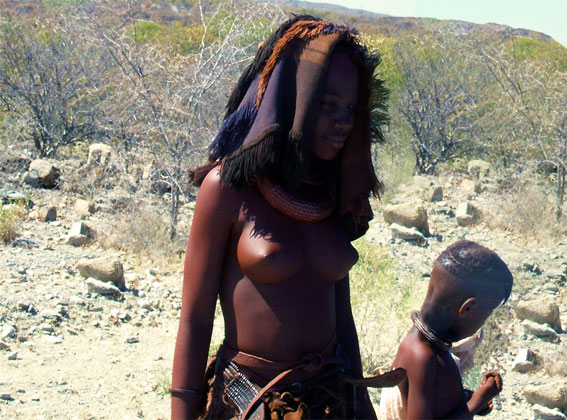 Himbas of Namibia
Himbas of Namibia
Like all frontiers inherited from colonial times, those of Namibia badly respect the ethnic distribution.
Peoples Herero , Ovambo and Bushmen are also divided between the former German colony (South West Africa) and neighboring states:
Angola, Botswana and South Africa .
» History
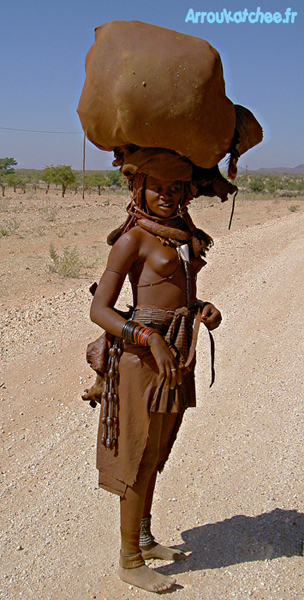 Himba Woman
Himba Woman
|
|
The Himba people would come by his stories with the Herero in the fifteenth and sixteenth centuries the Betschuanaland (Botswana today).
They lived as hunters and gatherers in north-western Namibia, in Kaokoland near the Kunene River (between Angola and the former homelands and Owamboland Damaraland).
The Himba are Herero are nevertheless differentiated among others by the influence of German missionaries on the Herero in fashion and their conflicts with the Nama .
The missionaries have indeed learned how to sew Herero women (women of German settlers were concerned that their husbands Herero violators when they see their chest).
These will soon be clothed in long robes and head coverings called Victorian Hererotracht.
The Herero were then quickly Christianized regarded as inferior Himbas animists.
In the nineteenth century, the Himba are chased by the German colonial army alongside the Herero.
Many took refuge in Angola, and work as scavengers for the Portuguese colonial power. After 1920, a reservation assigned to them by South Africa, which dominates Namibia for over seventy years.
However, they can not graze their cattle freely nor trade practice.
|
Livestock farmers are ruined as well.
Their reservation does not even have clean government.
In the eighties drought and war rages, the Himba culture is on the brink. About two thirds of their livestock (approximately 130 000 animals) die.
Many men are forced to engage in the South African army and fight against SWAPO guerrillas fighting for the independence of Namibia.
With the end of the rebellion and independence of Namibia, the rain comes too, and flocks of Himba rise again.
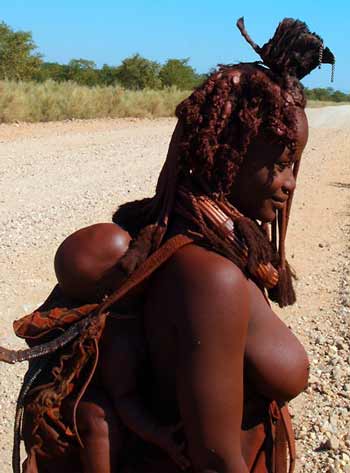 Himba woman with his baby
Himba woman with his baby
The Himba are, basically, from the Nile region in Egypt.
They are historically distant cousins of the Maasai. After a migration of several centuries, they arrived in Zimbabwe, Angola and Namibia.
The Himba are an ethnic group, who, like all peoples Herero, belongs to the Bantu language group, a set of ethnic groups covering the entire southern part of Africa. The Bantu are, above all, farmers, sedentary and gained control of the iron.
Around the fifteenth and sixteenth centuries, the Himba people, allegedly accompanied the Herero during the crossing of the river Kunene River border today between Angola and Namibia.
Lands where they arrive are already occupied, and its inhabitants hunted the Herero. Most of them continue their journey to the center of Namibia.
Only a small group decided to settle in Kaokoland, which means "faraway land" are the Himba.
They were forced to adopt a style of semi-nomadic life because of continual strife.
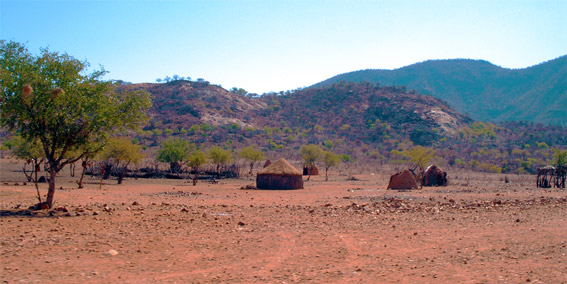 Himba village in the Kaokoland
Himba village in the Kaokoland
In the mid-nineteenth century, attacked and without herds, they are obliged to fall back to Angola.
To survive, they practice hunting and gathering, occupation rather humiliating for a nation of pastoralists.
This time they take their name: "Himba" means "beggars".
The Himba are Herero So other than, refugees after being forced from their territory.
In the 1920s, through the colonization of South Africa, the Himba again through the Kunene River , hoping to regain their land.
Gradually, they will rebuild and become, in the 1970s, the richest pastors in Africa.
But again, it does not last long because in 1980 a terrible drought and the war between the South African army for independence of the "SWAPO" doing their herd is again decimated.
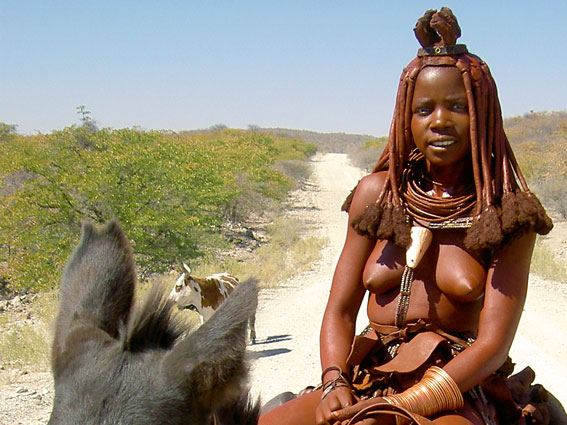 Himba woman
Himba woman
Patients, Himba survive on food aid, they are rebuilding their herds and return to their nomadic life.
Many of them have settled north of Opuwo , capital Kaokoland, where does most of the villages today, after work of evangelization carried out by white missionaries.
These facts are based on stories rather than on proven data.
The Himba are currently between ten thousand and fifteen thousand in Namibia.
They live mainly on their cattle and live in camps scattered throughout the Kaokoland with their herds of cows and goats.
But this figure remains, too, is uncertainty. Given their high mobility, the census is difficult.
» Lifestyle
In the desert tormented Kaokoland, Himba herders are struggling to preserve their ancestral way of life threatened by a long guerrilla war.
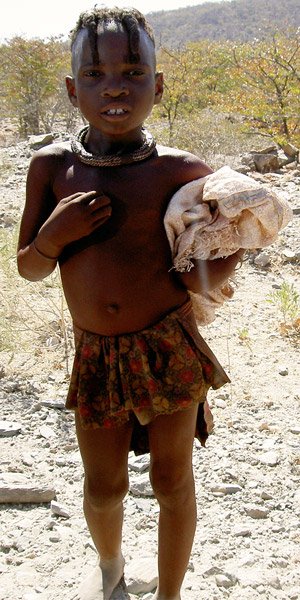 Himba Child
Himba Child
They are only a few thousand rude to perpetuating an ethic and frugal based on the eternal presence of the dead, embodied in their herds.
Their passion for physical beauty also makes an admirable witnesses Southern Africa, which now disappears.
» Culture
Traditionally, the Himba are tinged red skin with an ointment made of animal fat-based powder and hematite.
This ointment helps protect them from the heat of the sun, dry air, insects.
The Himba people, men and women are wearing a simple loincloth and leather sandals with manufacture of car tires.
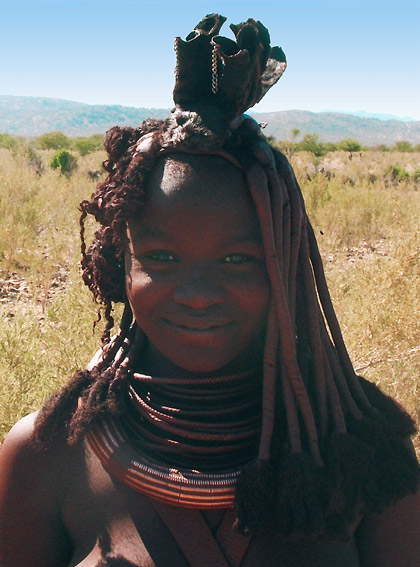 Woman of himba people
Woman of himba people
Currently communities organize to manage livestock and tourism which can represent a significant income because many tourists come to visit the Himba villages.
There are mobile schools, where children learn English. Himba culture has kept its originality despite external pressures and has a chance of survival by adopting sustainable forms of development.
The houses of the Himba have a conical shape and are made of palm leaves, the rich earth and cow dung.
In a family, they are the children of the sister who inherit cattle, while children receive livestock from the maternal uncle.
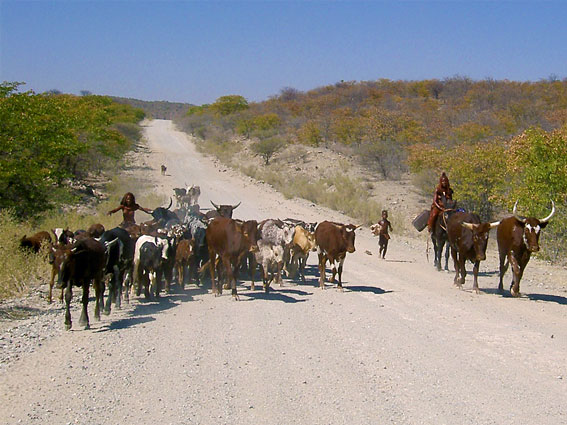 Himba with their cow herd
Himba with their cow herd
Only the "sacred flock" and the responsibility of the sacred fire is left to the son.
The light shall never die, as it maintains the relationship between the living and the dead.
» Photos
Pictures of Himba
|
|



